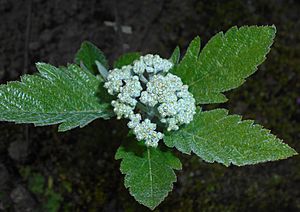Lesser whitebeam facts for kids
The lesser whitebeam (Sorbus minima) is a special kind of shrub that belongs to the whitebeam family. It's a unique plant found only in Wales. This plant is quite rare and grows in just a few places in an area called Breconshire.
Quick facts for kids Lesser whitebeam |
|
|---|---|
 |
|
| Conservation status | |
| Scientific classification | |
| Genus: |
Sorbus
|
| Species: |
minima
|
| Synonyms | |
|
Pyrus minima |
|
This plant reproduces in a very interesting way. It makes new plants without needing seeds from two different parents, which means it reproduces asexually. Because of this, it stays separate from its close relatives, like the Swedish whitebeam. Scientists think it might have started as a hybrid (a mix) between the rock whitebeam and the rowan tree.
The lesser whitebeam was first found in 1893 by Augustin Ley. He was a vicar who traveled a lot in Wales and discovered this unique plant.
What the Lesser Whitebeam Looks Like
The lesser whitebeam is a thin, deciduous shrub. This means it's a bush that loses its leaves in the autumn. It can grow up to three metres (about 10 feet) tall.
Its leaves are usually 6–8 centimetres (about 2.5–3 inches) long. They are narrow and oval-shaped. The leaves have pointed tips and bases. They also have 7 to 10 pairs of veins and are slightly lobed.
The plant's flowers appear in May and June. Their petals are small, about 4 millimetres long, and are white. After the flowers, the plant produces red berries. These berries are 6–8 millimetres across and have a few small spots called lenticels.
Where the Lesser Whitebeam Lives
This special plant grows on limestone cliffs. You can find it near a town called Crickhowell in the eastern part of the Brecon Beacons.
The biggest group of these plants is at Craig y Cilau National Nature Reserve. In 2002, over 700 plants were counted there. There are also smaller groups further west at Cwm Cleisfer. Sadly, only one plant remains at a place called Craig y Castell. It used to grow in another area called Blaen Onneu, but it's no longer there.
Protecting This Special Plant
The lesser whitebeam has faced some challenges. In 1947, the British Army was using the area where the plant grows for mortar practice. This put the plant in danger.
However, a politician named Tudor Watkins helped save it. He was a Labour MP for the local area. He spoke up in Parliament and convinced the War Secretary (a government official) to make the Army leave the area. Many people believe his actions saved the lesser whitebeam from disappearing forever.
Another threat to the plant has been quarrying. This is when people dig up rocks from the ground. Quarrying has destroyed many plants and reduced the amount of natural home (or habitat) available for them. While the plant can grow back in old quarries, it doesn't grow as thickly as it does in undisturbed areas.
Today, most of the places where the lesser whitebeam grows are protected. Also, some of these plants are kept safely at the National Botanic Garden of Wales. This helps make sure this rare Welsh plant continues to survive.


